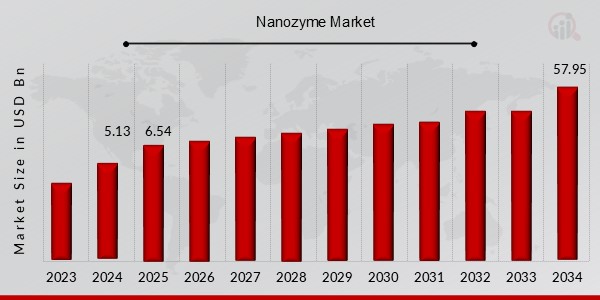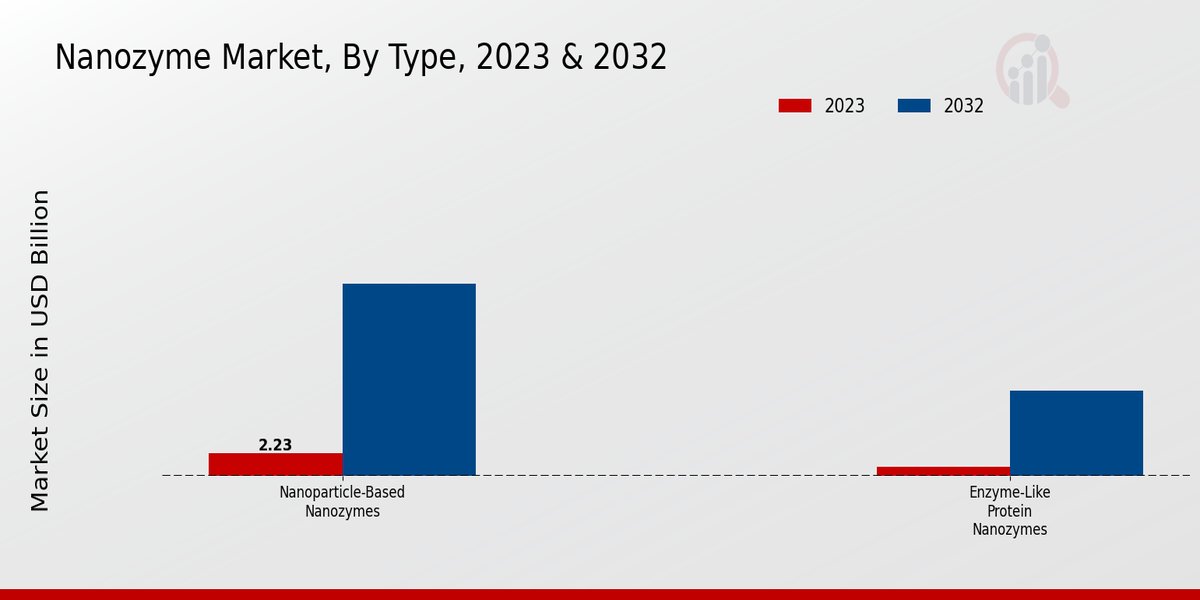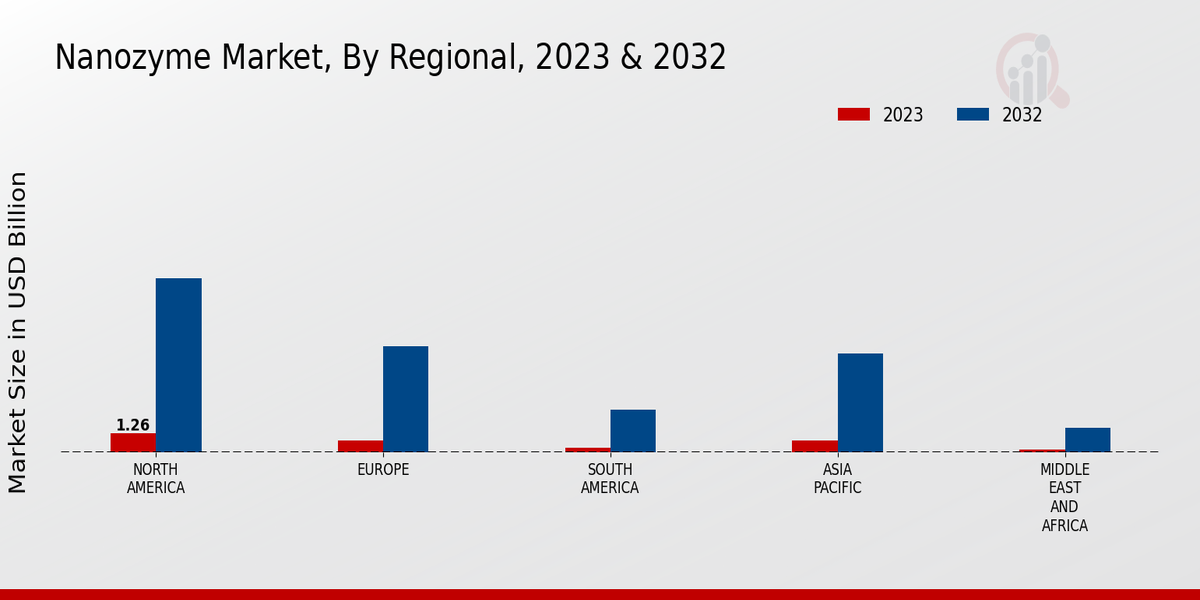Global Nanozyme Market Overview
The Nanozyme Market Size was estimated at 5.13 (USD Billion) in 2024. The Nanozyme Market Industry is expected to grow from 6.54 (USD Billion) in 2025 to 57.95 (USD Billion) by 2034. The Nanozyme Market CAGR (growth rate) is expected to be around 27.4% during the forecast period (2025 - 2034).
Key Nanozyme Market Trends Highlighted
The nanozyme market exhibits promising growth prospects, driven by advancements in nanotechnology and increasing applications in healthcare, environmental remediation, and industrial processes. Key market drivers include rising demand for rapid and accurate diagnostics, the development of innovative cancer treatments, and the need for sustainable solutions in various industries.
Opportunities lie in exploring applications in biosensing, drug delivery systems, and environmental catalysis. Recent trends indicate a surge in the use of nanozymes for point-of-care diagnostics, personalized medicine, and targeted drug delivery. Furthermore, the integration of nanotechnology with computational modeling is enhancing the design and optimization of nanozymes for specific applications. This trend is expected to continue, opening up new possibilities for research and development in the enzyme market.

Source Primary Research, Secondary Research, MRFR Database and Analyst Review
Nanozyme Market Drivers
Rising Demand for Advanced Diagnostics and Therapeutics
The increasing prevalence of chronic diseases and the growing need for personalized medicine are driving the demand for advanced diagnostics and therapeutics. Nanozymes offer unique advantages over traditional diagnostic and therapeutic agents due to their high specificity, sensitivity, and versatility. They can be engineered to target specific biomarkers, enabling early detection and personalized treatment of diseases. The ability of nanozymes to combine diagnostic and therapeutic functions into a single platform holds immense potential for improving patient outcomes and reducing healthcare costs.
As the healthcare industry continues to focus on developing innovative solutions for disease diagnosis and management, the demand for nanozymes is expected to surge in the coming years.
Advancements in Nanotechnology and Materials Science
The rapid advancements in nanotechnology and materials science have played a pivotal role in the development and optimization of nanozymes. The ability to synthesize and characterize novel nanomaterials with tailored properties has enabled researchers to design nanozymes with enhanced catalytic activity, stability, and biocompatibility. The development of scalable and cost-effective production methods is furthering the commercialization of nanozymes.
As nanotechnology continues to advance, it is expected to lead to the discovery of new nanozymes with even higher performance and broader applications in the Nanozyme Market Industry.
Growing Government Support and Funding
Governments worldwide are recognizing the potential of nanozymes in addressing healthcare challenges and promoting economic growth. Increased funding is being allocated to research and development initiatives focused on nanozymes. This support is expected to accelerate the development of nanozyme-based technologies and their translation into clinical applications. Government grants and incentives are also encouraging startups and established companies to invest in nanozyme research and commercialization.
This growing support from governments is a key driver for the growth of the Nanozyme Market Industry.
Nanozyme Market Segment Insights
Nanozyme Market Type Insights
Type Segment Insights and Overview The Nanozyme Market is segmented based on type into Nanoparticle-based Nanozymes and Enzyme-like Protein Nanozymes. Nanoparticle-based Nanozymes Nanoparticle-based nanozymes are artificial enzymes that mimic the catalytic activity of natural enzymes. They are typically composed of metal or metal oxide nanoparticles, such as gold, silver, or iron oxide, and can be tailored to exhibit specific enzymatic properties by controlling their size, shape, and composition. Nanoparticle-based nanozymes offer several advantages over natural enzymes, including enhanced stability, tunable activity, and the ability to perform reactions in harsh environments.
The Nanoparticle-based Nanozymes Market is expected to witness significant growth in the coming years, driven by increasing demand for enzyme-like catalysts in various industries, including healthcare, biotechnology, and environmental applications. In healthcare, nanoparticle-based nanozymes are being explored for use in disease diagnosis, drug delivery, and tissue engineering. In biotechnology, they are used in biocatalysis and biosensors. In environmental applications, nanoparticle-based nanozymes are employed for pollutant degradation and water purification.
Enzyme-like Protein Nanozymes Enzyme-like protein nanozymes are artificial enzymes that are composed of protein molecules engineered to mimic the catalytic activity of natural enzymes. They are typically designed by modifying the structure or sequence of natural enzymes or by creating new protein scaffolds that exhibit enzyme-like properties. Enzyme-like protein nanozymes offer several advantages over natural enzymes, including improved solubility, ease of production, and the ability to be tailored to specific applications. The Enzyme-like Protein Nanozymes Market is expected to grow rapidly in the coming years, driven by increasing demand for biocompatible and biodegradable enzyme-like catalysts in various industries.
In healthcare, enzyme-like protein nanozymes are being explored for use in enzyme replacement therapy, gene editing, and immunotherapies. In biotechnology, they are used in biocatalysis and biosensors. In environmental applications, enzyme-like protein nanozymes are employed for pollutant degradation and bioremediation. Overall, the Type segment of the Nanozyme Market is expected to witness strong growth in the coming years, driven by increasing demand for enzyme-like catalysts in healthcare, biotechnology, and environmental applications.
The market is expected to be dominated by Nanoparticle-based Nanozymes, but Enzyme-like Protein Nanozymes are expected to gain significant market share due to their advantages in terms of biocompatibility and ease of production. The projected market values are 2.231 USD Billion for Nanoparticle-based Nanozymes in 2023 and 19.427 USD Billion in 2032, and for Enzyme-like Protein Nanozymes, 0.929 USD Billion in 2023 and 8.613 USD Billion in 2032.

Source Primary Research, Secondary Research, MRFR Database and Analyst Review
Nanozyme Market Application Insights
The Diagnostics segment held the largest share of the Nanozyme Market in 2023 and is expected to continue to dominate the market throughout the forecast period. This is due to the increasing demand for rapid, accurate, and cost-effective diagnostic tests for various diseases. The Biomedical Research segment is expected to grow at a significant CAGR during the forecast period. Nanozymes are increasingly being used in biomedical research for applications such as drug discovery, disease diagnosis, and biomarker identification. The Environmental Monitoring segment is also expected to grow at a steady pace during the forecast period.
Nanozymes are being used to develop biosensors for detecting environmental pollutants, such as heavy metals, pesticides, and organic compounds. The Industrial Applications segment is expected to witness moderate growth during the forecast period. Nanozymes are being used in industrial applications such as catalysis, energy storage, and water purification. Overall, the Nanozyme Market is expected to grow at a robust CAGR during the forecast period, driven by the increasing demand for nanozymes in various applications across different industries.
Nanozyme Market Target Market Insights
The Nanozyme Market is segmented based on the target market into research institutions, pharmaceutical companies, diagnostic laboratories, environmental agencies, and industrial end-users. Among these, research institutions are expected to hold the largest market share due to the increasing research and development activities in the field of nanotechnology. Pharmaceutical companies are also expected to contribute significantly to the market growth due to the rising demand for nanozymes in drug development and delivery. Diagnostic laboratories are expected to witness a steady growth in the market due to the increasing use of nanozymes in diagnostic assays.
Environmental agencies are expected to play a key role in promoting the adoption of nanozymes for environmental remediation and monitoring. Industrial end-users are expected to drive the market growth due to the increasing demand for nanozymes in various industrial applications, such as food processing, textiles, and cosmetics.
Nanozyme Market Form Insights
The Nanozyme Market segmentation is broadly classified into Form, Application, End User, and Region. Among these segments, the Form segment is further sub-segmented into Liquid, Powder, and Nanoparticle Suspension. Liquid is the dominant form type, accounting for the largest market share due to its high stability, ease of handling, and wide range of applications in diagnostics and therapeutics. Powdered nanozymes are gaining popularity due to their ease of storage and transportation. Nanoparticle suspensions offer advantages such as increased surface area and enhanced catalytic activity, making them suitable for specific applications.
The market growth for the Form segment is driven by advancements in nanotechnology, increasing demand for nanozymes in healthcare, and growing awareness about their potential in various industries.
Nanozyme Market End-Use Industry Insights
End-Use Industry Segment The nanozyme market is segmented by end-use industry into healthcare, pharmaceuticals, diagnostics, environment, and agriculture. The healthcare segment is expected to hold the largest market share in 2023, with a significant contribution from the diagnostics sub-segment. The increasing use of nanozymes in early disease detection, biomarker discovery, and personalized medicine is driving the growth of this segment. The pharmaceuticals segment is also expected to witness significant growth due to the rising demand for nanozymes in drug delivery and targeted therapies.
In 2023, the nanozyme market revenue is estimated at USD 3.16 billion, and it is projected to reach USD 28.04 billion by 2032, exhibiting a CAGR of 27.43% during the forecast period. The environment and agriculture segments are also gaining traction due to the potential applications of nanozymes in environmental remediation, water treatment, and agricultural productivity enhancement.
Nanozyme Market Regional Insights
The Nanozyme Market is segmented by region into North America, Europe, APAC, South America, and MEA. In 2023, North America accounted for the largest share of the nanozyme market, and is expected to maintain its dominance throughout the forecast period. The region's large pharmaceutical and biotechnology industries, along with increasing research and development activities, are key factors driving the growth of the nanozyme market in North America. Europe is another major market for nanozymes, with a strong presence of leading pharmaceutical and research institutions.
The APAC region is expected to witness significant growth in the nanozyme market over the forecast period, due to the rising prevalence of chronic diseases and increasing healthcare expenditure in countries such as China and India. South America and MEA are also expected to contribute to the growth of the nanozyme market, albeit at a slower pace compared to other regions.

Source Primary Research, Secondary Research, MRFR Database and Analyst Review
Nanozyme Market Key Players And Competitive Insights
Major players in the Nanozyme Market industry are continuously engaging in research and development activities to enhance their product portfolio and gain a competitive edge. Leading Nanozyme Market players are focusing on developing innovative products with improved functionality and cost-effectiveness. The Nanozyme Market is witnessing the emergence of new players, which is intensifying competition and driving down prices. This competitive landscape is expected to continue in the coming years as companies strive to differentiate their products and capture market share.
Nanozyme Market development is being driven by several factors, including the increasing demand for advanced and efficient diagnostic and therapeutic tools. Leading Nanozyme Market players are investing heavily in research and development to meet this growing demand. Companies are also focusing on expanding their presence through partnerships and acquisitions. The Nanozyme Market is expected to witness significant growth in the coming years as these factors continue to drive market expansion.
A leading company in the Nanozyme Market is British Columbia-based Zymeworks. The company specializes in developing novel antibody-drug conjugates (ADCs) for the treatment of cancer. Zymeworks' lead product, zanidatamab, is an ADC that targets the HER2 protein, which is overexpressed in many types of cancer. Zanidatamab has shown promising results in clinical trials, and it is expected to be approved for marketing in the near future. Zymeworks is also developing a pipeline of other ADCs, which are expected to further strengthen the company's position in the Nanozyme Market.
Key Companies in the Nanozyme Market Include
-
Zhejiang Scenray New Material Technology Co., Ltd.
-
Purametrix
-
Wuxi New Ray
-
Alfa Aesar
-
American Elements
-
NX Filtration
-
Beijing Xiyuan New Material Technologies Co., Ltd.
-
Sigma Nanotechnology
-
SigmaAldrich
-
nanoComposix
-
Element Solutions Inc.
-
Qingdao Sanjin Chemical Co., Ltd.
-
LGC Standards
-
US Research Nanomaterials, Inc.
-
Strem Chemicals Inc.
Nanozyme Market Industry Developments
The nanozyme market is projected to witness substantial growth over the forecast period, driven by increasing demand for enzyme alternatives in various industries. The market growth is attributed to the rising need for cost-effective and sustainable enzyme alternatives, advancements in nanotechnology, and increasing applications in healthcare, environmental remediation, and food processing. Key players in the market include Merck KGaA, BBI Solutions, and Solvias AG, among others.
Nanozyme Market Segmentation Insights
Nanozyme Market Type Outlook
- Nanoparticle-based Nanozymes
- Enzyme-like Protein Nanozymes
Nanozyme Market Application Outlook
- Diagnostics
- Biomedical Research
- Environmental Monitoring
- Industrial Applications
Nanozyme Market Target Market Outlook
- Research Institutions
- Pharmaceutical Companies
- Diagnostic Laboratories
- Environmental Agencies
- Industrial End-Users
Nanozyme Market Form Outlook
- Liquid
- Powder
- Nanoparticle Suspension
Nanozyme Market End-Use Industry Outlook
- Healthcare
- Pharmaceuticals
- Diagnostics
- Environment
- Agriculture
Nanozyme Market Regional Outlook
- North America
- Europe
- South America
- Asia Pacific
- Middle East and Africa
| Report Attribute/Metric |
Details |
| Market Size 2024 |
5.13 (USD Billion) |
| Market Size 2025 |
6.54 (USD Billion) |
| Market Size 2034 |
57.95 (USD Billion) |
| Compound Annual Growth Rate (CAGR) |
27.4% (2025 - 2034) |
| Report Coverage |
Revenue Forecast, Competitive Landscape, Growth Factors, and Trends |
| Base Year |
2024 |
| Market Forecast Period |
2025 - 2034 |
| Historical Data |
2020 - 2024 |
| Market Forecast Units |
USD Billion |
| Key Companies Profiled |
Zhejiang Scenray New Material Technology Co., Ltd., Purametrix, Wuxi New Ray, Alfa Aesar, American Elements, NX Filtration, Beijing Xiyuan New Material Technologies Co., Ltd., Sigma Nanotechnology, SigmaAldrich, nanoComposix, Element Solutions Inc., Qingdao Sanjin Chemical Co., Ltd., LGC Standards, US Research Nanomaterials, Inc., Strem Chemicals Inc. |
| Segments Covered |
Type, Application, Target Market, Form, End-Use Industry, Regional |
| Key Market Opportunities |
Biosensor development Drug delivery Tissue engineering Diagnostics Biocatalysis |
| Key Market Dynamics |
Growing demand for biosensors Advances in nanotechnology Increasing applications in healthcare Rising environmental concerns Government support for research and development |
| Countries Covered |
North America, Europe, APAC, South America, MEA |
Frequently Asked Questions (FAQ) :
The Nanozyme Market is anticipated to reach USD 5.13 billion in 2024.
The Nanozyme Market is projected to exhibit a CAGR of 27.4% during the forecast period from 2025 to 2034.
North America is expected to account for the largest market share in the Nanozyme Market by 2034.
Major application segments include diagnostics, therapeutics, environmental applications, and biosensors.
Key players in the Nanozyme Market include Merck, Sigma-Aldrich, BBI Solutions, and TANBead.
Advancements in nanotechnology, increasing demand for personalized medicine, and growing environmental concerns are driving market growth.
The market is expected to witness increased competition with new entrants and strategic collaborations.
Regulatory hurdles, limited reimbursement policies, and scalability issues pose challenges to market growth.
Rising healthcare expenditure, technological advancements, and expanding applications in various industries present growth opportunities.
The Nanozyme Market is anticipated to reach USD 57.95 billion by 2034.
















